The Role of Giardia lamblia in Day Cares
Introduction
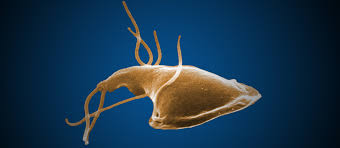
By Ifeoma Archimalo
Day care centers have a high rate of children catching bacterial infections. The risk of infection due to people to people contact with the children is great because of their developing immune systems. Preventative measures are not always taken increasing the spread of infections around the children. The frequency of infections to occur from day care centers is very high and increases with factors such as social class, age, and race[1]. Children tend to touch things and put them into their mouths more out of habit. Their direct contact increases their chances of getting an infection especially if they have not been vaccinated.
Children may be carriers of infection and not show any symptoms or signs. Other children around them have a possibility of receiving the disease. Yet, they are still all at risk for respiratory, diarrheal, hepatitis A, and Streptococcus. With some of these diseases, there are vaccinations that can protect the child against receiving it. Those who are not, have a higher chance of getting sick. Children who already have an infection are already immune compromised and are at a greater risk for getting another one.
It is important to know the significance of the risks of infection from disease because it could harm children as they grow older. Reduced reading comprehension or compromised cogitative ability could delay educational performance. The increased exposure to day care centers can give light to new infections that are drug resistant. Although this is rare, these infections can turn into a greater problem that have the possibility of hospitalizing children. These infections influence infant morbidity which had led to an increase in health care services. Families that are in lower social classes have issues getting the service that their children need. The increased rates for children health care has caused parents to lose their jobs because they cannot afford it anymore.
In low socioeconomic areas, not all day care center workers have not been properly trained in food handling and other healthcare standards for day care centers. The direct contact with hands is a leading factor in infections. Surfaces and hands of the employees are easy targets for the diseases to spread. Transmission of diseases also can occur if children continue to go to the center if they are sick. Direct contact with them could spread their disease to everyone. Diaper changing areas are the most vulnerable to the spread and bathrooms. Toilet trained children are usually carriers of the infection due to their lack of knowledge of bathroom hygiene. If proper hygiene is not taken in the areas, pathogens such as Giardia flourish.
Diarrheal disease is one of the major infections day care centers must watch out for. Although many outbreaks occur in developing countries due to poor sanitation, children are still vulnerable to the disease because of direct contact with a person who is infected and contaminated food and water. Giardia lamblia, the leading cause of Giardiasis, is a disease that many can get from direct contact. The poor hygiene habits that children have increase the chances of getting the disease.
The spread of bacterial infections is high in day care centers. However, in areas of low socioeconomic background the rates are higher. The lack of knowledge of hygiene and of poor public sanitation makes it easy for waterborne diseases to occur. The parasite Giardia lamblia is the leading cause of the diarrheal disease, giardiasis, in children who go to day care centers. The parasite was actively seen in day care centers in the late 70s and 80s due to high incidence of the diarrheal disease in toddlers and some of the day care center workers[2]. Although the disease is not deadly, it is highly contagious, but easily preventable. This report seeks to highlight the effects of the parasite in day care centers in low socioeconomic areas.
What is Giardia Lamblia
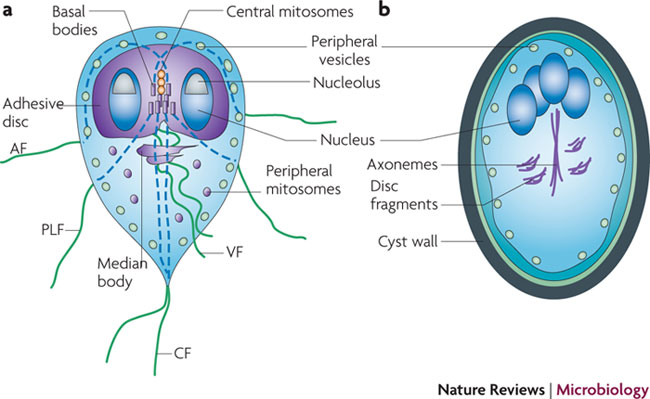
Giardia lamblia is a common pathogen found in contaminated areas including water and feces. They have several other names such as G. duodenalis and G. intestinalis. They are the most popular parasite diagnosed in the intestines[3]. It is the cause of giardiasis. It has four flagella, two for each nucleus. Its tear drop shape allows for the two nuclei to fit. The trophozoite can survive a long time outside the host until it is under stress. The parasite then goes through differentiation where the cyst turns in to a trophozoite [4]. The parasite is a problem in water communities around the world, but popularly in day care centers. Antoine van Leeuweenhook first described it in 1681. It was originally named Cercomonas intestinalis by Lambl in 1859 until Stiles changed it in 1915 to what we know now[3]. The parasite is not limited to only humans. Dogs, cattle, and other animals can also spread them. Developing countries experience many problems with Giardia lamblia due to the poor sanitation and hygiene
[1].
Giardia lamblia’s different cell bodies for two stage life cycle allows for significant functions necessary for the stages to function. During the cyst stage, the have four nuclei, a double membrane, a filamentous exterior and membrane interior, and the ER. They are about 7 to 10µ in diameter and the membrane is 0.3 to 0.5µm thick. At the trophozoite stage, they are about 12um to 15m long and 5 to 9 µm wide. In figure 2, the organelle in the parasite differ between the two stages because of the amount of functions in each of the cycles. Besides the four flagella in the anterior, posterior, caudal, and ventral regions, and two identical nuclei, it contains vacuoles, endoplasmic reticulum, and a ventral disk. A stacked membrane found in the trophozoite implies that the ER should be there; the ER is only shown when encysting trophozoites. They lack the mitochondria in both stages, however in the trophozoite phase, mitosomes are present suggesting some mitochondrial function from them. The nuclei replicate at the same time to ensure equal numbers of genes in both. The ventral disk is very important in the survival of the trophozoite. It allows cell body to bind to the wall of the small intestine. The concave structure contains contractile proteins such as actin and myosin to help function in the adherence of the parasite. The flagella allow the parasite to move, not to bind. In the trophozoite phase, they go through anaerobic respiration stimulated by glucose. Giardia lamblia uses carbohydrate metabolism through the EM pathway, but there are some strains of Giardia that use other substrates to start metabolism like amino acids. The cyst still goes through anaerobic respiration, but it is stimulated by ethanol. The metabolic rate in the cyst is very slow since it is dormant at this stage[5].
Transmission of the Infection
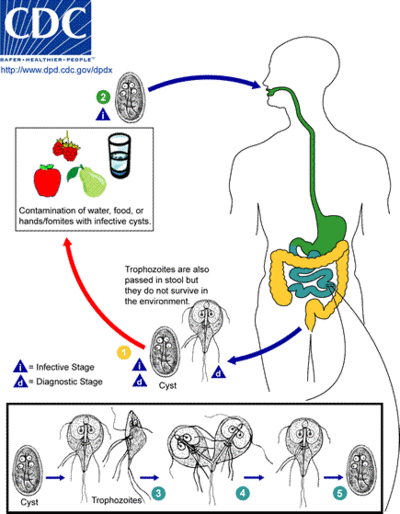
Contaminated water, food, or person to person contact allows the parasite to spread easily. The image above shows a computational model of how the parasite grows and spreads in the body. The Giardia lamblia cyst or trophozoite is ingested in it lives in the intestines. However, the trophozoites die since they cannot withstand the conditions. Its hard-shell exterior allows the cyst to survive until it is triggered. It has two life stages: the dormant cyst stage and the trophozoite stage. It stays in the dormant cyst stage until it enters an environment of high pH such as stomach acid. Encystation and excystation occur in order to release the trophozoite and form a cyst when it hits the colon. After initial ingestion of the cysts, they go through the small intestine first. Excystation in the intestines releases two trophozoites. They can either move from the small intestine to the colon or attach to the mucous lining of the small intestine using their adhesive ventral discs[5]. If they go to colon, they then go through encystation. The cysts are dormant but still infectious in feces. This increases the transmission of the infection between people greatly[6]. Depending on how great the infection is, the entire lining of the intestine could be lined with the trophozoite. Attachment of the parasite also depends on the active metabolism and environment of where it is located. If the trophozoite is in an environment where it is inhibited at 37˚C or increased oxygen levels, the microtubules in the ventral disk form a base with proteins at the end to allow for the disk to attach[5]The life cycle of Giardia is shown in Figure 3. The movement of the parasite though the host to the target area shows the change of shape from trophozoite to cyst stage. The structure of Giardia at each stage dictates function.
Giardiasis
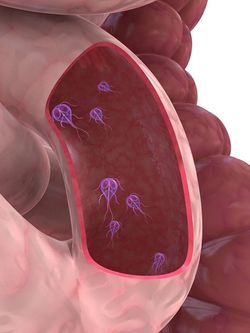
Giardiasis is a diarrheal disease that infects the intestines[7]. It is also called beaver fever because most of the cases of the infections come from beavers. In an experiment done by Duffy et al. determining the prevalence of Giardiasis in children in Brazil using detection test, they found that children with low zinc, iron, and vitamin A are most vulnerable to the infection. It could take weeks or months until it is triggered. As few as 10 cysts can infect a person. If infected, the person experiences diarrhea, gas, greasy stool, stomach cramps, nausea, and dehydration. Figure 3 demonstrates the movement of the parasite. The four flagella allow it to move into the small intestine and bind to the lining. Giardia is shown in the trophozoite phase. At this stage, the symptoms of the disease occur. The host becomes highly contagious. Giardia lamblia are shown floating through the small intestines. However, some can be infected and not experience any symptoms. The infection lasts about two to six weeks with the proper treatment. It is found in the soil, contaminated water and food from infected humans or animals, or surfaces. The parasite infects those orally. Polis et al. found that the some of the outbreaks found in the United States were from water sources contaminated by beaver feces being the host[2].
Prevalence in Day Care Centers
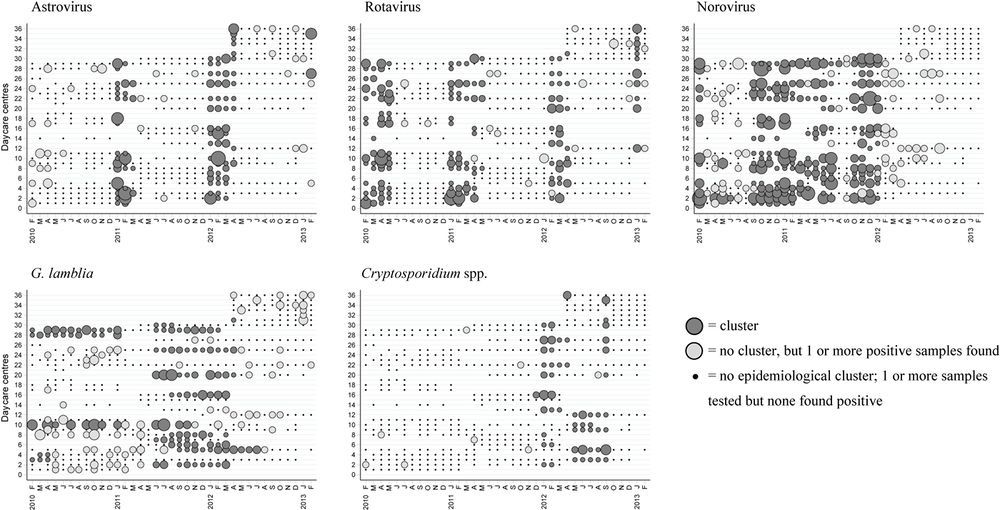
Besides industrial areas and developing countries, the transmission of the parasite is very vulnerable in day care centers [8]. The lack of hygiene in infants and toddlers make them potential carriers of the parasite. The amount of contact they make with others makes it easier to spread the infection. Ingestion of Giardia lamblia by touching changing tables, diaper bags, toys, or bathroom handles that have contaminated feces on them increases the chances of getting the infection in the center[7].
Children exposure to contaminated water and food are also sources of the parasite. If the child ingests either contaminated water or food, the parasite will survive in their body contaminating their feces. Contact with other children in the day care centers increases the likelihood of infection due to their poor hygiene. However, the likelihood of the caregivers receiving the infection is lower because they have better hygiene than children.
Polis et al. performed one of the earliest diagnosis of the parasite in day care centers during the major outbreak in the 70s and 80s. They found that the parasite is transmitted through people to people contact, more specifically child to parent contact. They observed that most of the children who were infected were those who were not toilet trained. However, they found that not only does overcrowding and poor sanitation lead to the infection, but the people to people contact spreads the infection. This was shown through their control group that they had used who ended up getting the infection. They concluded that Giardia was symptomatic [2].
In developing countries, the likelihood of a child getting giardiasis in day care centers is high due to the poor hygiene and sanitation of the city. In an experiment performed by Santos et al., they looked at the prevalence of the Giardia parasite and others in children who go to public day care centers in southeastern Brazil. Not only did they test the children in the center, but they also tested those who live in their household, their pets, and the caregivers who handle the food. By using PCR to diagnose the infection, they looked at those who had a very large quantity of cysts; the more of the cysts, the better the amplification. They found that Giardia parasite was the most dominant. The children and those who handle the food were most at risk for the infection. The crowded conditions and the poor hygiene make it easy for the children to spread the parasite between each other. This also demonstrates how other pathogens spread among children. Those that handle the food are at risk because of the poor hygiene used to prepare meals for the children. If proper care is not taken when handling food, the parasite can easily be spread. They did not find the infection in the family members or in the pets showing that the parasite is spread through people interaction [8].
In an experiment performed by Duffy et al., they looked at the different methods of testing the spread of the infection in day care centers in Guatemala by using three methods: light microscopy, enzyme-linked immunosorbent assay (ELISA), and rapid dipstick method. Two samples were also used two samples to determine if the infection had passed or if it was in the dormant phase of the cycle. They found that the rapid dipstick method would be best in rapid screenings. They are sensitive to the cysts and can handle the larger spread of the cysts. On the other hand, the ELISA method found many more infections in the samples than the other two methods. This could be that it was more sensitive to the cysts even though it could not handle patients who have a larger spread of the cyst infection. The absorbance level of the test is not high enough to test larger quantities of the cyst [9].
Studies have found that areas lower socioeconomic regions have a higher chance of getting water bore diseases especially Giardia lamblia. However, all regions still have a chance of getting the parasite and the disease associated. In an experiment performed by Pijnacker et al. clustering was used in a day care center in The Netherlands. In The Netherlands, more than half of toddlers contract a type of gastrointestinal illness. Over half of the toddlers in the stat attend day care centers. They found that centers with wading pools and sandpits are likely to have a contamination disease. A high frequency of Giardia lamblia was found especially in sandpits which was not expected to happen. The high frequency in the sand pits was also found in another experiment that the authors referred to throughout the article. Giardia is known to cause waterborne illnesses; however, the authors believe that the contamination in the pits was caused by feces. It was also prevalent in wading pools, but not as much as the sandpit. Figure 5 shows the dark, large clusters of the virus throughout the time they were studying. Increased cleaning of toys that have been in mouths and objects with vomit on them showed a decreased frequency of the parasite. The application of cleaning techniques is shown in the size of the clusters.[10].
Studies from Santos et al, Duffy et al, and Pijnacker et al show how socioeconomics can affect the spread of waterborne diseases in children, especially those that attend day care centers. The parasite Giardia lamblia is the most common organism found in contaminated water. Day care centers that are in the lower socioeconomic areas such as Brazil and Guatemala demonstrate that poor sanitation leads to contaminated water that the children consume and spread within each other. A study done in Ghana by Anim-Baidoo et al about the spread of Giardia found that giardiasis spreads most through those who do not have the proper knowledge about hygiene and poor sanitation increased the chance of contracting the disease. Ghana is a developing country that has struggled in the past with giardiasis especially in children under the age of five. Public health education has increased which improved sanitation, and the rates of giardiasis have decreased by half from the max 10% in 2013 to 5.8% in 2016. Mothers who have more of an educational background saw a decrease of infection in their children. The authors also found that children who ate more street food, had a higher risk of contracting giardiasis. This is due to the vendors not cleaning the food properly and the hygiene of the area. The frequent interactions between the toddlers and playing outdoors in areas of contamination spreads Giardia faster [11].
Testing and Treatment
Giardia is observed by testing the stool samples. Duffy et at. used light microscopy, ELISA, and rapid dipstick method to diagnose the disease [9]. Santos et al. used PCR amplification, and Polis et al. used a direct smear test[2]. Cyst or trophozoites are tested to determine the infection. Duffy and Santos both wanted samples that had a large quantity of cysts in them to show how much the infection has spread. It was not stated how Polis observed the stool samples.
There are several methods in order to treat Giardia. At the moment, metronidazole, tinidazole, and nitazoxanide are used[7]. Other treatments for the infection are nation specific but still are effective. Children are given furazolidone because it can be suspended. Metronidazole is the most popular used, but there has been some drug resistance in all the methods. Peptide antibiotics and new methods have been used to combat the resistance.
Practicing proper hygiene such as washing hands in day care centers will prevent the spread of Giardia lamblia. Keeping children that have acute diarrhea at home is the best way to contain the parasite. To maintain an environment free of the parasite, disinfection of the play areas including toys that have been in mouths, and washing hands after changing diapers. Those who prepare food should not change diapers without washing their hands[12].
Conclusion
Giardia is one of the most common waterborne infections in the world. Direct contact is another major way the parasite is spread especially in day care centers. Poor hygiene with children who just become toilet trained and food contamination are ways that it spreads around. Lower class and developing areas are more prone to the infections because the workers are poorly trained on bathroom and diaper changing procedures and the water in the area. Water is tested daily in the United States, however in other countries, it is not tested as frequently as seen in Santos et al.
References
- ↑ 1.0 1.1 Nesti et al.: Infectious diseases and daycare and preschool education. Journal de Pediatria 2007 83:299.
- ↑ 2.0 2.1 2.2 2.3 Polis et al.: "Transmission of Giardia Lamblia from a Day Care Center to the Community." American Journal of Public Health 1986 12:1142-1144.
- ↑ 3.0 3.1 “Giardia”, “MicrobeWiki” Retrieved on 28 April 2017.
- ↑ Foster, John W., and Joan L. Slonczewsi (2016). “Microbiology: An Evolving Science”. W W Norton. ISBN 0393614034.
- ↑ 5.0 5.1 5.2 Adam et al.: Biology of Giardia Lamblia. Clinical Microbiology Reviews 2001 14(3): 447–475.
- ↑ “Parasites - Giardia”, “CDC” Retrieved on 28 April 2017.
- ↑ 7.0 7.1 7.2 “Parasites - Giardia: General Information”, “CDC” Retrieved on 28 April 2017. Cite error: Invalid
<ref>tag; name "General" defined multiple times with different content - ↑ 8.0 8.1 Santos et al.: Epidemiological, Parasitological and Molecular Aspects of Giardia Duodenalis Infection in Children Attending Public Daycare Centers in Southeastern Brazil. Transactions of the Royal Society of Tropical Medicine and Hygiene 2012 106:473.
- ↑ 9.0 9.1 Duffy et al.: Prevalence of Giardiasis in Children Attending Semi-urban Daycare Centres in Guatemala and Comparison of 3 Giardia Detection Tests. Journal of Health, Population, and Nutrition 2013 31:290. Cite error: Invalid
<ref>tag; name "Duffy2013" defined multiple times with different content - ↑ Pijnacker et al.: Characteristics of child daycare centres associated with clustering of major enteropathogens. Epidemiology and Infection 2016 144(12):2527-39.
- ↑ Anim-Baidoo et al.: Giardia lamblia infections in children in Ghana. The Pan African Medical Journal 2016 24: 217.
- ↑ “Giardiasis”, “Daycare” Retrieved on 28 April 2017.
Authored for BIOL 238 Microbiology, taught by Joan Slonczewski, 2017, Kenyon College.
